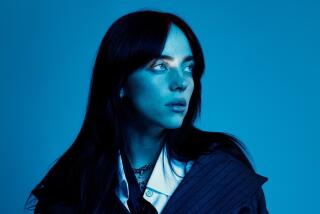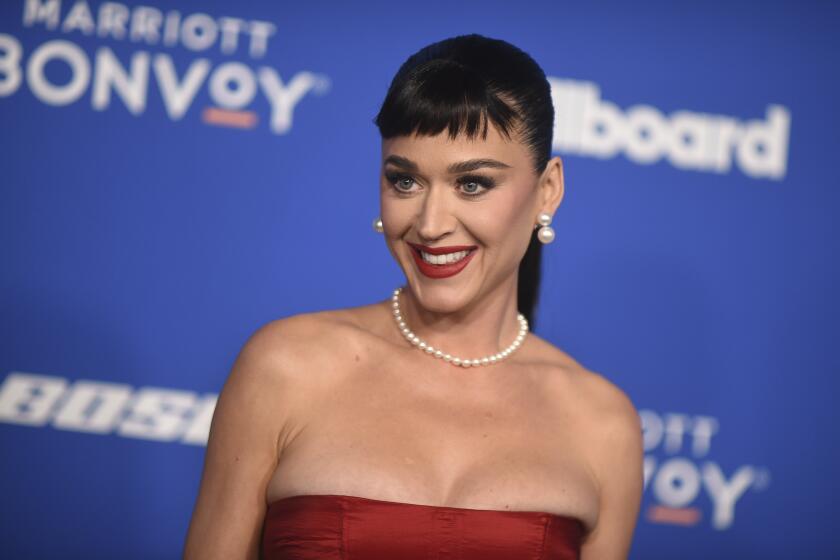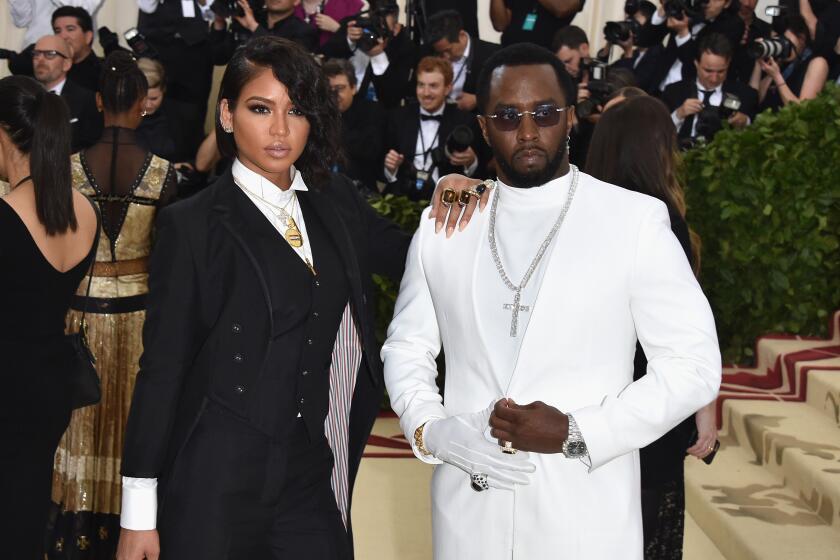A Musical Crossover, on a Grand Scale
At first the scene looks and sounds like jazz, not tango.
There’s burly Joe Lovano, one of the most acclaimed U.S. jazz artists today, playing a burly saxophone. Paquito D’Rivera, a onetime protege of Dizzy Gillespie, on clarinet. Dave Samuels, who has performed with Oscar Peterson and Stan Getz, on vibraphone.
But among the sounds filling the restaurant in the Uruguayan countryside there floats the lament of a bandoneon, the accordion-like instrument that is the soul of the tango.
The jazzmen have joined forces with the Quintet for New Tango led by Argentine pianist Pablo Ziegler, who made his mark with master composer Astor Piazzolla. Rehearsing Piazzolla’s “Fugue and Mystery,” the ensemble wails and growls and slides from tango to jazz and back again.
The Latin American and U.S. artists performed a swinging tribute in January to Piazzolla at the Punta del Este Jazz Festival--another sign of rising international interest in the tango, particularly the obsessive genius of Piazzolla.
The first Piazzolla biography was published in the U.S. last year. Top musicians from the jazz and classical worlds are busy recording his works. They compare him to Ellington, Gershwin, Stravinsky. They say he tore down walls to create a New World art form: “American” music, in the hemispheric sense.
“This is really the first time I’m working with Piazzolla’s music and it’s amazing,” said Lovano. “It’s a fusion of jazz and classical and modern classical with also Afro-Cuban roots in there too somehow.”
After his death in 1992, Piazzolla’s star continued to rise. He has inspired musical tributes by figures including Japanese cellist Yo-Yo Ma, Latvian violinist Gidon Kremer and U.S. jazz guitarist Al Di Meola.
Nonesuch Records has reissued three Piazzolla recordings: the classic “Tango Zero Hour” from 1986, widely considered a Piazzolla masterpiece; “The Rough Dancer and the Cyclical Night (Tango Apasionado),” the soundtrack from a 1987 stage production that was conceived and directed by Argentine choreographer Graciela Daniele and featured D’Rivera in the ensemble; and “La Camorra: The Solitude of Passionate Provocation” from 1989.
“He took tango [like jazz, a tradition with murky origins] and turned it into a form of contemporary chamber music,” says the biography “Le Grand Tango” by Argentine anthropologist Maria Susana Azzi and British author Simon Collier. Piazzolla was “constantly crossing frontiers and exploring diverse musical cultures and genres. He was a living embodiment of both integration and crossover.”
Like many U.S. artists, Lovano’s career has been steeped in the Brazilian and Afro-Cuban sounds that enriched jazz during half a century. But only recently has Lovano--twice named Downbeat magazine’s jazz artist of the year--joined the musicians who are exploring and expanding the frontier where tango and jazz converge.
Lovano’s grandparents were from Sicily. Piazzolla’s melancholy Italianate strains strike a chord; it’s like Sicilian blues.
“For me the tango was something we played at gigs, parties and weddings,” he said. “It was just songs. But to be in an ensemble with this beautiful orchestration, it’s a lot like playing with certain big bands. Everything is really written out, but you’re free to interpret your part. And that’s really the beauty of Piazzolla’s music.”
Lovano performed with Ziegler and D’Rivera in a watershed concert last year at Carnegie Hall. He guest-starred on the latest CD by Ziegler, who tours the United States, Europe and South America from his base in New York.
Ziegler, who has wavy gray hair and a goatee and projects an unpretentious cool, plans to feature Lovano and D’Rivera on his quintet’s next recording. He hopes tango will have the kind of impact on jazz that other Latin American styles had in decades past.
It’s a mission inherited from Piazzolla, a revolutionary who transformed Argentine dance music into the “new tango”--a genre that was simultaneously cerebral and sensual, gritty and sophisticated. It demanded serious listening. Like jazz.
Piazzolla recruited Ziegler in 1978 precisely because of the pianist’s classical and jazz credentials. At the time, Ziegler had a band that specialized in jazzing up Debussy and Schubert.
“Piazzolla had always wanted a pianist who didn’t come out of the tango,” said Ziegler, 56. “Everything was written out in Astor’s music, but I started to improvise. And he would say: ‘Yes, I like that. Improvise. But don’t improvise in jazz, improvise in tango.’ We made his quintet much jazzier. Tango and jazz approached each other. And we reached a point which I have taken as the starting point for my group.”
Today, Ziegler is the closest there is to a Piazzolla heir, according to Azzi, the biographer. The tribute featuring Ziegler in Punta del Este was the idea of D’Rivera, the musical director of the festival held on a dairy farm. He attracts a spectrum of U.S. and Latin talents to a 6-year-old event that is getting bigger and better: This year’s lineup mixed stalwart seniors such as drummer Roy Haynes and saxophonist Johnny Griffin with young lions, including pianist Danilo Perez and bassist Christian McBride.
D’Rivera, a Cuban exile, grew up with the tango. The Cuban habanera was a thread in the musical tapestry--along with the African rhythms of ex-slaves and the nostalgic poetry of Italian and Spanish immigrants--that became the tango in the brothels and saloons of Buenos Aires and Montevideo in the early 1900s.
‘That’s Not Tango,’ He Was Told at First
In addition to celebrating Argentina’s contributions to jazz, D’Rivera wanted to honor Piazzolla as a 20th century great.
“What happened to him is like what happened to Charlie Parker,” D’Rivera said. “In the beginning they told him ‘That’s not tango.’ Like they told Charlie Parker, ‘That’s not jazz. . . .’ The same with Beethoven. Then later people discovered they were geniuses.”
It’s hard to imagine now how much trouble Piazzolla stirred up. It’s also important to remember how big an impact U.S. culture had on him.
He was born in the Argentine city of Mar del Plata in 1921 but moved to New York at age 4 and lived there until he was 16. The move began a lifetime of globe-trotting and made him an uprooted, nostalgic wanderer with an outsider’s perspective.
Piazzolla’s father, an Italian immigrant barber, taught his son to love the tango. The young Astor fell in love with the big bands of Duke Ellington and Cab Calloway in Harlem and hung out with roughnecks and boxers--including a teenage Jake La Motta, the future champion to be immortalized in the movie “Raging Bull.” For the rest of his life, Piazzolla spoke a fluent English heavy with the inflections of Little Italy.
Piazzolla studied bandoneon with a Hungarian neighbor and became a virtuoso. His New York tastes raised eyebrows, though, when he returned home and got his start in the smoky bars of downtown Corrientes Avenue, the Broadway of Buenos Aires. The old-school tango musicians had never heard a bandoneonist play “Rhapsody in Blue” or “Sophisticated Lady.”
That was nothing compared with the uproar in the 1950s when the well-known but financially strapped Piazzolla returned from France on a cargo ship and unleashed a barrage of innovative compositions on the musical world.
Disdainful of traditional dance music and intent on becoming an “Argentine Gershwin,” as he put it later, he studied in Paris with Nadia Boulanger, a mentor of Aaron Copland and others.
Boulanger liked the symphonies Piazzolla had written--until he played her one of his tango pieces. She stopped him after eight bars and told him to throw away his other works: The tango was his calling. That was his epiphany.
Unfortunately, the Argentine musical establishment disagreed with Boulanger. They were aghast at Piazzolla’s harmonic and rhythmic experimentation. They condemned the “new tango” as dissonant, pretentious, undanceable and a sacrilegious assault on an Argentine institution.
“It was as if he had set fire to the flag,” Ziegler said. “His great sense of humor is what saved him.”
Death threats and physical attacks are part of Piazzolla lore: Once a vengeful purist threw gas on his band and tried to set them on fire. But the temperamental artist withstood the abuse and prided himself on his New York street smarts.
He was also a restless, chain-smoking, insomniac perfectionist, a stern taskmaster with his sidemen. They, in return, held him in awe.
“He was a one-man movement,” Ziegler said. “In Brazil in the 1960s you had Bossa Nova; in other countries you had Latin American sounds. . . . There were a lot of people making that music. But the new tango was Piazzolla.”
Coming Into His Own, but Slowly
Ziegler toured with Piazzolla’s quintet during the years when the master finally achieved acclaim: Piazzolla wrote a sonata for cellist Mstislav Rostropovich and performed with jazzmen Gerry Mulligan and Gary Burton.
Despite today’s Piazzolla boom, he is not exactly pushing Ricky Martin off the charts. He is reasonably well-known in Europe and increasingly in the United States, though many U.S. listeners still identify tango primarily with slick-haired and sultry dancers.
“You’ll see a Piazzolla concert with dancers, which is something he detested,” said Azzi, who lives in Buenos Aires and has written extensively on the tango.
Azzi is particularly disappointed with the limited appreciation in Argentina of Piazzolla’s prolific artistry--he registered 3,500 compositions. The lack of biographies is symptomatic.
“People here say they admire Piazzolla, but they might know a dozen of his pieces,” she said. “There is a certain superficiality. Argentines still don’t realize his importance.”
Meanwhile, Ziegler soldiers on. He lives in Brooklyn and maintains two quintets, one in New York and one in Buenos Aires.
For his next recording project, Ziegler has immersed himself in the milonga and the murga, musical cousins of the tango. They are rooted in an Afro-Argentine culture of the late 19th century that has almost vanished. The drum-heavy murga is performed by colorfully dressed neighborhood groups that recall the samba schools of the Brazilian carnival.
“This is what remains of our black heritage,” Ziegler said. “I really like it. I want to try to do something sophisticated with it. Take a bit of a break from just Piazzolla.”
That’s how a Piazzolla heir takes a break: with a Piazzolla-esque expedition into the magic and majesty of street music.
More to Read
The biggest entertainment stories
Get our big stories about Hollywood, film, television, music, arts, culture and more right in your inbox as soon as they publish.
You may occasionally receive promotional content from the Los Angeles Times.






